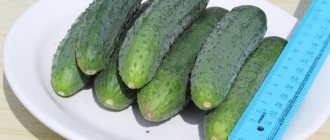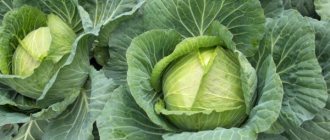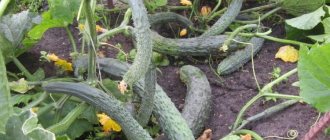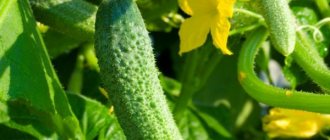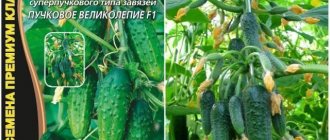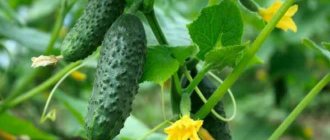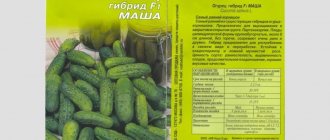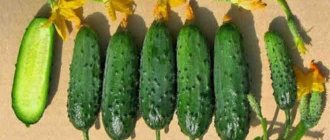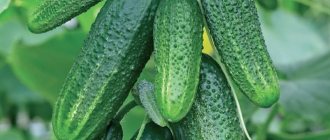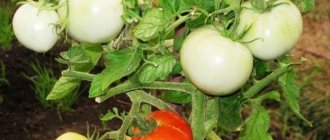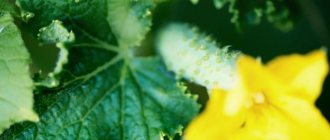» Vegetable growing » Cucumbers » Varietal characteristics of cucumber Uhazher
0
2726
Article rating
The Uhazher cucumber was bred by breeders as a medium-ripening hybrid. In 2004 it was entered into the state register. Created for cultivation in greenhouse conditions in small enterprises and garden plots.
- Advantages and disadvantages
- Landing
- Seeds in the ground
- For seedlings
- Care
- Disease and pest control
- Reviews from gardeners
Varietal characteristics of cucumber Uhazher
Characteristics of the cucumber variety Uhazher
The Uhazher cucumber variety was developed by Sedek in 2007. Among its advantages, first of all, it is noted for its early ripeness, due to which the Ugazher matures before the period of spread of diseases.
Characteristics of cucumbers of the Ukhazher variety
Description of the variety
The plant is an early ripening plant. On average, 42-45 days pass from sowing to harvest. The bushes are powerful, medium in size, and have a female type of flowering. Fruit weight - 70-95 g. Length - about 12 cm. The surface of the cucumbers is tuberous, cylindrical in shape.
There is no need to wait until the cucumber grows to its maximum size: the gherkin is no less tasty.
Advantages and disadvantages
Uhazher cucumbers are distinguished by their crispy flesh and delicate taste. However, in addition to excellent taste characteristics, the description highlights a number of other advantages of the variety:
- long fruiting period;
- high yields;
- attractive presentation of the fruit;
- long storage period;
- high level of disease resistance.
Planting a variety
The Ukhazher cucumber, like other varieties, is highly sensitive to cold, so during planting the soil temperature should reach 17-18°C. In the fall, the site is dug up and all remnants of vegetation are removed. Acidic soil is limed.
Sowing method
In the spring, around mid-April, the ground is dug up again and leveled with a rake. After waiting until mid-May, humus is added, as well as mineral fertilizers and wood ash. The soil is treated with a solution of potassium permanganate (so the seeds, and later the sprouts, will be protected from diseases), then covered with a dark-colored film.
Choose a warm day for sowing seeds. The seeds are sown to a depth of no more than 1.5-2 cm. After germination, the bed is thinned out, leaving the strongest plants. The distance between them should be about 20-25 cm.
Seedling method
Cucumber Uhazher f1 is sown as seedlings and a month later they are planted on the site, adhering to a number of rules:
- Fill cups about 9 cm deep with light and fertile soil and sow at a distance of approximately 1.5-2 cm from the surface;
- planting in the ground is carried out when the temperature at night is not lower than 14°C, during the day - 18-20°C;
- water the ground 2 times a week, in the morning, with warm, settled water;
- don't forget to use fertilizers;
- 10 days before planting, seedlings begin to harden on the site.
Good care increases productivity
To get the desired result and achieve high yields of Ujazher f1 cucumbers, you need to properly care for the plants. Basic recommendations:
- in summer, feed cucumbers 4-5 times with mineral and organic fertilizer options;
- initially water moderately: 4 liters of water per 1 sq. m once every 5 days;
- when flowering begins and then fruiting begins, use 10 liters of water per 1 square meter. m every 3 days;
- form the plant into one stem, and also leave side shoots.
Pest treatment
The cucumber variety Uhazher f1, like any other, can be affected by pests, namely:
- spider mite;
- melon aphids;
- whitefly;
- slugs.
Spider mite
If yellow dots and barely visible cobwebs become noticeable on the leaves, a spider mite has infested the plant. Since it loves low humidity, the first remedy against the pest is to spray the leaves in hot weather up to several times a day.
An infusion of onion or garlic also comes to the rescue. It is used several times during the summer. Dill is planted next to cucumbers: it attracts ladybugs, which are the enemies of ticks. Planting seedlings as early as possible reduces the risk of infection. Another option is to treat plants with insecticides.
melon aphid
To combat melon aphids, first of all, it is necessary to keep the beds clean and remove any remaining vegetation for the winter. Plants are treated with infusions of celandine, onions, and potatoes. An infusion of tree resin also helps. Sometimes pesticides are used.
Disease and pest control
Cucumber Suitor can be affected by the following pests:
- spider mite;
- melon aphid;
- whitefly;
- slugs
The mite entangles the plant in a barely noticeable web, and because of it the leaves become covered with yellow dots. Spraying foliage in hot weather is the first remedy against these pests. Dill is also planted next to the crop: it attracts ladybugs, which love to feast on ticks.
Melon aphids are removed with infusions of onions, celandine or potatoes. In advanced cases, chemicals are used. To prevent diseases, it is necessary to keep the beds clean.
Whiteflies are controlled with glue traps. Hot pepper tincture helps against slugs. In addition, spruce or pine needles are buried in the soil around the plant.
Agricultural technology and proper cultivation
“Uhazher” is intended for cultivation in greenhouses and stationary greenhouses in small households. Sowing of seedlings is carried out in April. Sowing without seedlings in a greenhouse is carried out in May, when the soil temperature does not drop below 14*C.
Plants do not tolerate dense planting well, so the density of planting should not exceed 2.5 plants per 1 sq.m.
Vigorous plants of this cucumber require high-quality and regular pinching. The bushes form strictly into one stem. All stepsons and ovaries below the 4th node must be removed. The growth stem is pinched after twisting onto the top crossbar of the trellis.
The rest of the care is standard:
- Moderate watering to prevent the soil from drying out;
- Fertilizing with alternating organic and mineral complexes up to 4 times per season;
- Loosening the soil and weeding.
Features of agricultural technology of bee-pollinated crops
The seed manufacturer indicates that the Uhazher F1 cucumber can be grown with or without seedlings. Agricultural technology includes standard rules:
- the seedlings are moved to the beds after the formation of 3–4 leaves;
- direct sowing is possible after the soil has warmed to 14 degrees;
- the optimal number of bushes per 1 m2 is 2.5;
- before fruiting begins, watering frequency is once every 3 days;
- During the period of active fruit formation, the cucumber should be watered daily.
Period to start growing seedlings | Transplanting seedlings (protected beds) | Placing seedlings (open beds) | Stepsoning | Harvest dates |
| April | Beginning of May | May or first days of June | — | From the end of June |
| *recommendations correspond to weather conditions in central Russia | ||||
Description of cucumbers
Uhazher is a mid-early hybrid that is recommended to be grown in seven regions of Russia: Middle Volga, Central Black Earth, Central, Volga-Vyatka, North Caucasus, North-West and North.
Its early ripening helps to avoid diseases and the negative effects of insect pests.
Distinctive features
The fruits differ from other types of cucumbers in the following ways:
- cucumbers are covered with tubercles with white spines;
- the skin is thin, bright green with white stripes;
- large size: length from 15 to 18 cm, diameter up to 4 cm;
- cylindrical shape;
- weight from 180 to 200 g.
In the photo there is a cucumber Uhazher.
Properties, benefits, calorie content
Cucumber is a dietary product that is 95% water and contains 15 kilocalories per 100 g of product. It contains vitamins, fiber, organic acids and other beneficial substances. The presence of a large amount of water in the vegetable helps remove toxins and waste from the body, cleanse the kidneys and liver of heavy metal salts.
Fiber, which is present in large quantities in fruits, cleanses the stomach and improves intestinal function. Cucumber contains beta-carotene, magnesium, potassium, zinc, folate and other minerals.
Cucumber perfectly quenches thirst, improves appetite, and helps digest food. The dietary product is used in various recipes for weight loss.
Characteristics of the Uhazher hybrid
Cucumber is pollinated by bees, grows on loamy-humus or sandy loam soils, is resistant to low temperatures, and does not require special care. The fruit ripening period is medium-late, from 55 to 60 days.
The main characteristic features of the Suitor:
- the root system is voluminous, absorbs moisture from the soil well, reaches 30 cm in depth;
- the bush is large, low, with male and female inflorescences;
- the stem is strong, powerful, with a climbing pattern from 60 cm to 1.5 meters;
- the leaves are large, dark green, smooth, wavy at the edges; arranged alternately on the stem;
- the taste is pleasant, sweetish;
- the yield is high - up to 6 kg are harvested from one bush, from 1 sq. m up to 16 kg of cucumbers;
- the seeds are oblong and milky cream in color.
Planting a variety
The Ukhazher cucumber, like other varieties, is highly sensitive to cold, so during planting the soil temperature should reach 17-18°C. In the fall, the site is dug up and all remnants of vegetation are removed. Acidic soil is limed.
Sowing method
In the spring, around mid-April, the ground is dug up again and leveled with a rake. After waiting until mid-May, humus is added, as well as mineral fertilizers and wood ash. The soil is treated with a solution of potassium permanganate (so the seeds, and later the sprouts, will be protected from diseases), then covered with a dark-colored film.
Choose a warm day for sowing seeds. The seeds are sown to a depth of no more than 1.5-2 cm. After germination, the bed is thinned out, leaving the strongest plants. The distance between them should be about 20-25 cm.
Seedling method
Cucumber Uhazher f1 is sown as seedlings and a month later they are planted on the site, adhering to a number of rules:
- Fill cups about 9 cm deep with light and fertile soil and sow at a distance of approximately 1.5-2 cm from the surface;
- planting in the ground is carried out when the temperature at night is not lower than 14°C, during the day - 18-20°C;
- water the ground 2 times a week, in the morning, with warm, settled water;
- don't forget to use fertilizers;
- 10 days before planting, seedlings begin to harden on the site.
Good care increases productivity
To get the desired result and achieve high yields of Ujazher f1 cucumbers, you need to properly care for the plants. Basic recommendations:
- in summer, feed cucumbers 4-5 times with mineral and organic fertilizer options;
- initially water moderately: 4 liters of water per 1 sq. m once every 5 days;
- when flowering begins and then fruiting begins, use 10 liters of water per 1 square meter. m every 3 days;
- form the plant into one stem, and also leave side shoots.
Planting seeds for seedlings
Before planting seeds, you need to decide in which containers it will be planted. Many gardeners use plastic jars or compact wooden boxes sized to fit the windowsill.
Planting in special peat pots guarantees minimal trauma to the root system during transplantation. These containers are designed to be moved into the ground along with the plant.
The second stage of work is preparing the optimal soil, which in chemical composition should be similar to the one where the plant will develop after transplantation. In specialized stores you can purchase ready-made soil mixture for cucumbers or prepare temporary soil yourself. To do this you need to mix:
- chernozem 10 l;
- humus 3 l;
- wood ash 250 g;
- medium-grained sand 2 l;
- double superphosphate 2 tbsp;
- potassium sulfate 1 tbsp.
Seeds that are suitable for further planting
Seedlings are planted 20-25 days before the expected transplant date. During transplantation, the average daily air temperature should be at least +20° C.
2 seeds are planted in one container, laying them flat sideways at a depth of 1-2 cm. After this, the soil is pinched and sprayed with water using a spray bottle, subsequent watering must be provided every 2 days. After the cotyledon leaves appear, the weaker plant is removed.
For active development of seedlings, good lighting is required without direct sunlight. In darkened rooms, it is recommended to enhance diffused daylight with lamps and mirrors that reflect the sun's rays. A good impetus for the development of seedlings is given by fertilizing with a solution of nitrophoska (3 tsp) and water (3 l).
Many gardeners harden off a young plant by taking it out into the fresh air for 3-4 hours during the last week before replanting.
Description
This species has a medium weave, large leaves with a pair of shoots. Cucumbers begin to bear fruit approximately 2 months after planting. One node has a pair of ovaries. The size of cucumbers is approximately 17 cm, the diameter of the plant is up to 4 cm, and the weight of one fruit is about 200 grams.
Cucumbers have large white spines and the plant is regular and oval in shape. Externally, the vegetable looks beautiful, it can be used for transportation. In addition, this variety lasts for a long time and retains its appearance. Cucumbers taste excellent in any form. Another positive side is disease resistance.
In some cases, vegetables may be hollow, so Ujazher is more often used for preservation. The marinade is preserved for a long time, since the marinade does not get inside the fruit. Excellent yield is obtained not only if the variety is grown under film or in a greenhouse. There will be good performance in the soil, the main thing is to properly care for the species. In this case, you can eat delicious cucumbers before the onset of frost.
Harvesting and application
Uhazher cucumbers are harvested in the second ten days of August. Due to the uneven ripening of the fruits, harvesting continues in September-October.
The suitor is a prickly cucumber, so they pick it from the bushes with gloves on, put it in boxes, and store it in a cool place for about a month.
The fruits are suitable for use in salads, fresh and canned. Canned or pickled vegetables turn out very tasty - the brine does not get inside the cucumber, the skin remains dense and crispy.
Rules of care
There are a few simple rules to get a good harvest.
- Shosha f1 cucumbers can be planted through seedlings and directly into the ground. This must be done no earlier than mid-April. If you plant seedlings, they must have at least four leaves. When planting seedlings, make sure that the roots of the plant do not bend; place good drainage, such as sand, at the bottom of the hole.
- Seeds should be planted in open ground when the ground is sufficiently warm. The air temperature should be stably established at least 15-17o
- Since this is a tall variety, it needs support along which the stems can curl.
- At a height of up to 50 cm, all lateral shoots and flowers should be removed - they interfere with the plant’s growth and development.
- Seeds should be planted at the rate of 4 plants per 1 m2, but no closer than 50 cm between plants. The seed sowing depth is 3.5-4 cm. The purchased seeds have undergone special treatment against pests; this will not affect the quality of the crop, but they cannot be eaten.
Reviews from gardeners
Svetlana, 37 years old, Rostov region
Every year I try to buy new varieties of cucumbers. I grow them in open ground. Last year I purchased Ukhazher cucumber seeds based on the description of the variety and photo. The variety fully met expectations. In open ground there were no problems with pollination. Cucumbers go well in salads. Part of the harvest is sent for sale and is sold out very quickly.
Evgeniy, 48 years old, Tula
I bought Uhazher F1 cucumber seeds based on reviews and photos. Late ripening variety, pollinated by bees. The taste is excellent, we use it mainly for salads. When growing the variety Uhazher noticed that many male flowers were growing. Next year I plan to use it to pollinate other varieties of cucumbers with female flowering.
Marina, 52 years old, Novosibirsk
Uhazher cucumber is my favorite salad variety; I have been planting its seeds for 4 years in a row. It grows well in a greenhouse, pollination occurs due to insects. To attract bees and wasps, I planted several marigolds in the greenhouse. The fruit tastes sweet, the skin is thin and not bitter. In closed ground it bears fruit until October, even when the temperatures outside are already sub-zero. Uhazher is a very cold-resistant variety; I recommend it for growing in unstable climatic conditions.
Planting a variety
Growing Ukhazhir cucumbers is possible both by seed and by sowing seedlings, and the choice of a specific option depends more on the climatic characteristics of the region and the availability of film cover recommended by the manufacturer. In any case, each of the described methods has its own nuances of the procedure. Sowing seeds for seedlings is carried out in March or April and involves preliminary disinfection of the planting material in a Fitosporin solution, which will help avoid disease damage during further cultivation.
Read more about when to sow cucumbers for seedlings.
Once the seeds have swelled, they are placed in a damp cloth and left there for several days, controlling the humidity. After such preparation, the cucumbers are planted in separate seedling containers or peat-humus cups, which will help avoid picking plants in the future.
The ideal soil for cucumber plantings should consist of peat, sawdust and compost, combined in a 2:1:1 ratio. For five liters of the finished mixture, you need to add one tablespoon of nitrophoska and wood ash, and then fill each seedling pot with the substrate. The depth of planting seeds is no more than 5 mm, so you can simply spread the seeds on the surface of the soil and lightly sprinkle them.
At the end of the planting process, the seedlings are watered and the boxes are transferred to a warm room with an air temperature of +23...+27°C. To increase temperature levels and create a greenhouse effect, boxes with cucumbers should be covered with plastic film, periodically removing it to ventilate the plantings.
Important! Tomatoes, cabbage, onions and perennial herbs are deservedly considered the best predecessors for cucumbers, but it is better not to plant them after pumpkin plants.
There are also a number of requirements for the conditions for growing cucumber seedlings:
- daytime temperature should be maintained within +20°C, and night temperature should not fall below +16°C;
- sufficient lighting provides exposure to light for 12 hours (if necessary, it is worth installing additional sources of daylight above the seedling containers);
- air humidity should not be lower than 70%.
You will be interested to know how to properly plant cucumbers in open ground.
The planting pattern for the Uhazher variety is 50×50 (the distance between neighboring plants in a row and the rows themselves), and the planting depth depends on the size of the peat pot with which the cucumber seedlings are planted in the garden bed or under a film cover. Upon completion of planting, each bush should be watered with three liters of relatively warm water.
Cucumber planting scheme.
How to grow your own
The suitor is grown in two ways - seedlings or direct planting in the ground. It is better to plant a plant that will ripen indoors using the seedling method. In warm regions, seeds are sown in the ground.
Seedling method
Before planting seeds for seedlings, it is recommended to pre-germinate the seeds. Then the plant will take root better in the ground, and the first shoots will appear faster. Seeds for seedlings are prepared in the following ways:
- First they are selected and calibrated. Discard damaged, small seeds so that the seedlings grow evenly. To separate bad seeds from good ones, it is advised to put them in a saline solution (dissolve two tablespoons of salt in a liter of water) - bad quality seeds will float to the surface.
- Then they warm up. They are placed in a linen or cotton bag and placed in a place where sunlight hits or on a battery. Warm the seeds for several days, shaking the bag regularly to mix them.
- Next they are disinfected. Seeds are disinfected with a 1% manganese solution for 20 minutes, and with 3% hydrogen peroxide for 10 minutes. A solution of boric acid helps in treating seeds - half a teaspoon is dissolved in a glass of water, copper sulfate - a quarter of a teaspoon is added to a glass of water. Soak cucumber seeds in one of these solutions for up to three hours. It is recommended to use fungicides: Fitosporin-M, Trichodermin. Among folk remedies, aloe juice and garlic solution are used.
- Afterwards, plant growth is stimulated by soaking the seeds in the chemical preparations “Gumi” and “Epin-Extra”.
After swelling, the seeds are placed in a damp natural cloth for two days and wrapped. It is periodically moistened with water to provide moisture to the seeds. They are planted for seedlings at the end of March - beginning of April in peat pots.
To avoid pruning the plant, one seed is placed in each of them. The mixture for future seedlings is prepared independently from humus, peat, sawdust in a ratio of 2:2:1.
Plant the seeds horizontally at a shallow depth of 3 cm or sprinkle with soil 5 mm thick. Water the future seedlings with warm water from a sprayer so that it does not erode the soil. The air temperature should not be lower than +23°C.
On a note. To increase the temperature and create a greenhouse effect, the container with seeds is covered with film, then regularly turned over to allow fresh air to enter.
Germinated seeds require the following conditions:
- daytime temperature +20°C;
- evening temperature not lower than +16°C;
- regular lighting – 12 hours;
- constant hydration.
To ensure that light constantly reaches the seedlings, lighting devices are turned on above them. Cucumbers are watered weekly with warm water, which is pre-settled for several days. When two leaves appear on the plants, they are transplanted into separate pots or cups. The air temperature in the room is reduced for several days to +17°C.
In the second ten days of May or the first ten days of June, the seedlings are transferred to a permanent place in the ground. Plants that have formed three to four leaves are transplanted at a distance of 50x50 cm from each other in a peat container. Each plant is watered with 3 liters of water.
Reference . It is better to plant the hybrid on soil where tomatoes, onions, and cabbage previously grew. Planting in beds where pumpkins or zucchini grew is not recommended.
Seed method
The area for planting cucumbers is prepared in the fall: the beds are dug up and fertilizers are applied. The hybrid loves sunlight, so for planting they provide access to lighting and protection from the wind. It is better to place the beds from east to west, with a height of 30 cm.
With the onset of spring, in the second half of April, the soil is dug up again and the beds are leveled with a rake. In mid-May, the soil is fertilized with compost, ash, and mineral fertilizers. Disinfect the soil with a solution of potassium permanganate and cover it with a dark film. Cucumbers are sown in warm, sunny weather to a depth of 1.5 to 2 cm with a distance between seeds of up to 20-25 cm.
Growing in stages and care
A good harvest of the Uhazher hybrid depends on proper care - and, first of all, on timely watering and fertilizing. Let's look at these procedures in more detail.
Irrigation scheme:
- before the formation of buds - weekly 3 liters of water for each bush;
- at the flowering stage and fruit formation - every 3 days, 6 liters of water.
Before watering, the water is pre-settled in a large container so that it warms up. Spray the bushes in the morning and evening, then loosen the soil and pull out the weeds. In hot weather, make sure that the soil around the bushes is not covered with dry crust.
The Ujazher hybrid is fed by:
- two weeks after planting the plants in the soil;
- when the ovary begins to form;
- during the appearance and growth of fruits.
In hot weather it is better to apply root fertilizing, in cool weather - foliar fertilizing. To do this, use a solution of cow manure or bird droppings - add 1 liter of mullein to 15 liters of water, mix and apply at the rate of 4 liters of fertilizer per 1 square meter. m of planting cucumbers.
Spray the plants with a solution of 15 g of urea, 25 g of potassium sulfate, 30 g of mineral phosphorus fertilizer in the morning or evening. You can replace mineral fertilizers with ash - it enriches the soil with useful substances and repels insect pests. As the hybrid grows, the stepsons under the third leaf are removed and the bushes are tied up.
Features of cultivation and possible difficulties
Hybrid Uhazher is an unpretentious vegetable crop. Features of growing cucumbers are:
- protect plantings in open ground from spring frosts;
- water regularly in hot weather and drought to prevent the appearance of bitterness in the fruits;
- irrigate with warm water until the ovary forms after 2-3 days;
- Cucumbers should be fed and fertilized two weeks after planting in open ground;
- remove excess shoots, hill up bushes.
Diseases and pests characteristic of the hybrid
Hybrid Suitor suffers from various diseases and pests, regardless of whether it grows in a greenhouse or in open soil:
- Melon aphid. To combat, the crop is treated with infusions of potatoes, garlic, onions, celandine, tree resin, and fungicides.
- Spider mite. The plant is sprayed with water at the first appearance of yellow spots and cobwebs on the leaves.
- Slugs . Infusions of hot pepper, pine or spruce needles are added to the soil. They use ammonia and chemicals.
- Whitefly. Glue traps help. If necessary, treat with infusion of garlic or onion.
The boyfriend is resistant to the following diseases: root rot, powdery mildew, cucumber mosaic. In these cases, the hybrid does not need to be treated with pesticides.
Cucumber “Uhazher f1”: unpretentious and very tasty
The new mid-late, bee-pollinated hybrid cucumber “Uhazher f1” is intended for open ground and film greenhouses. The main advantage of this variety is its high yield.
The description of the hybrid form is given by the originator, who is.
The cucumber of the hybrid form “Uhazher f1” is included in the State Register of the Russian Federation and is recommended for growing in garden plots, household plots and small farms. Growing under a film covering is optimal.
The Uhazher f1 cucumber has received very high praise from vegetable growers, and reviews of this hybrid form are almost always positive. Cucumbers of this variety are great for both salads and pickling. Greens are always crispy and very tasty, and are also extremely rarely bitter.
The variety shows consistently high yields not only in greenhouses, but also when grown on ridges in open ground. Harvesting takes place before frost. The Uhazher f1 cucumber has indeed established itself as an unpretentious variety of universal use. He is affected by diseases quite rarely and easily tolerates insufficient quality care.
Brief list of advantages and disadvantages
When listing the advantages of the variety, they mention the following:
- The culture is highly disease resistant.
- The fruits are dense, which helps maintain their quality during transportation.
- The vegetable is aromatic, without bitterness.
- A cucumber picked from a bush can be stored for a long time.
- Productivity is not inferior to hybrids of the parthenocarpic type.
- The low tendency to branch makes it easier to care for the bushes.
Minuses:
- there is no possibility of propagating the crop by seeds from personal harvest;
- it is inconvenient to preserve long fruits;
- prickly cucumber.
Characteristic
The Uhazher variety has many positive characteristics, but first of all it is worth paying attention to the yield indicators, flowering and fruiting times of cucumber bushes. Find out the benefits and harms of cucumbers.
Find out the benefits and harms of cucumbers.
Flowering and fruiting times
The first harvest of Ukhazhir cucumbers is harvested approximately 55–60 days after emergence, that is, at the end of July or beginning of August. If you sow the seeds in time a second time, then in greenhouse conditions it will be possible to harvest two crops per year. Flowering of cucumber bushes is observed approximately 1–1.5 months before harvesting the greens.
Productivity
In good growing conditions, it is quite possible to harvest about 5–6 kg of greens from one cucumber bush, while the marketable yield of 1 m² of plantings is at least 15–16 kg. Fruiting is extended over time and in some cases continues until frost.
Resistance to pests and diseases
Like most other hybrid crops, cucumbers of the Ukhazher variety have increased resistance to typical diseases and are not afraid of diseases (powdery mildew, root rot, cucumber mosaic). This means that even without the use of fungicidal and insecticidal compounds, you have every chance of getting a high-quality harvest, without chemical impurities.
Important! To start collecting Uhazhior cucumbers, you do not have to wait until they reach their maximum size. Small specimens also have good taste, the main thing is to remove the skin with a large number of small spines in a timely manner. In addition, high resistance to diseases is maintained even after long-term storage of the collected fruits: they do not rot or spoil, and their skin retains its integrity even after prolonged storage. transportation of greens
In addition, high resistance to diseases is maintained even during long-term storage of the collected fruits: they do not rot or spoil, and their peel retains its integrity even during long-term transportation of the greens.
Brief information about the variety
- Fruits and bush : green cucumbers, 15-18 cm long. The bush is indeterminate (unlimited growth of the main vine).
- Productivity : 4-6 kg per plant.
- Resistance : to frosts and autumn cold spells. Resistant to powdery mildew, cucumber mosaic and root rot.
- Distribution : suitable for all regions, but in the middle zone and northern regions the variety is cultivated in greenhouse conditions and planted in heated soil.
- Application : suitable for both fresh consumption (in salads) and canning.
- Planting : seeds in open ground and seedlings. They are planted in the soil in April, and for seedlings in March-April. Planting pattern – 50x50.
- Soil : loamy-humus or sandy loam.
- Care : fertilizing and watering are carried out in three stages - after planting, during budding, during fruiting. Bush formation is not required.
- Ripening period : The crop ripens in late summer. Fruiting lasts until the first frost. It is possible to store cucumbers for a long time.
